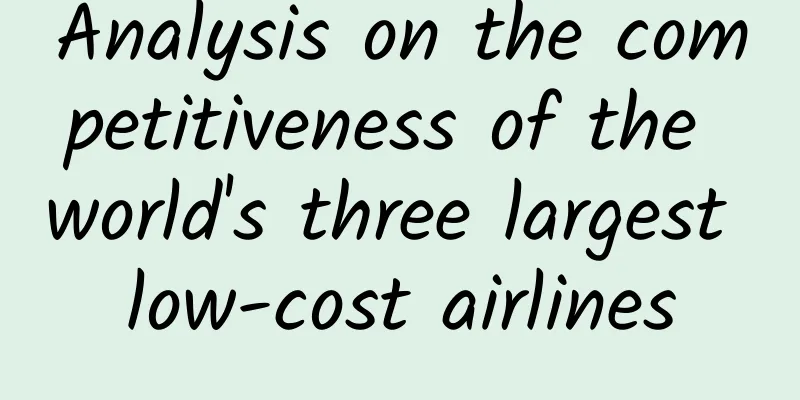Analysis on the competitiveness of the world's three largest low-cost airlines

|
This is probably the most detailed analysis of low-cost airlines in history. Southwest Airlines, Ryanair and AirAsia are the regional flagships of the world's low-cost airlines, located in North America, Europe and Asia respectively. They have the same "low ticket price and high occupancy rate" operating model, and each has innovated the "revenue and profit growth" business model to lead the popular growth of global aviation. The three low-cost airlines were established in 1971, 1985 and 2001 respectively. Southwest Airlines focuses on the US market (domestic market accounts for 99%, and TransAsia Airlines acquired by Southwest has a small number of South American routes). After 42 years of development, it has become the largest airline in the United States in terms of passenger transportation volume. In 2012, the domestic passenger transportation volume in the United States accounted for 25%. Ryanair is based in Europe. After more than 20 years of development, it has surpassed Lufthansa to become the world's largest international airline. In 2012, the international passenger transportation volume was nearly 80 million. In terms of passenger transportation volume, Ryanair is also the largest low-cost airline in Europe and the largest airline in the European region. After more than 10 years of development, AirAsia has become the largest low-cost airline in Asia, and its passenger transportation volume ranks among the top five in Asia. 1. Southwest Airlines - the company model and originator of the low-cost strategy, the world's largest low-cost airline Southwest Airlines (NYSE: LUV), headquartered in Dallas, Texas, USA, is a benchmark and model of refined operation management, maintaining 42 years of continuous profitability, even in the industry crisis (the "911 incident" in 2001) and economic depression (the global economic crisis in 2008). Relying on the huge market in the United States, Southwest Airlines has created a low-cost, direct flight, multi-hub route network operation model, which has changed the aviation market structure and enhanced the value and contribution of aviation in the transportation system. On September 27, 2010, Southwest Airlines acquired Air Tran and expanded into the South American market. In 2012, Southwest Airlines was ranked seventh on Fortune magazine's "Top 10 Most Admired Companies in the World" and was awarded the title of Global Customer Service Champion. Southwest Airlines route network coverage is as follows (Figure 1): Southwest Airlines' market share is shown in the following figure (Figure 2): In 2012, it had a market share of 71% on routes to the top 100 cities in the United States and a market share of 25% in the domestic market. The number of daily flights to the top 10 airports in the United States reached 100-200. The North American low-cost airline market share is shown below (Figure 3): Southwest Airlines has considerable room for development. Southwest Airlines has a comparative advantage in unit seat cost among North American airlines. See the following figure (Figure 4): Southwest Airlines' financial performance is shown in the following figure (Figure 5): business revenue continues to grow, maintaining 42 consecutive years of profitability, and profit margins have declined. Since 2008, profitability has been in a recovery period. Southwest Airlines fleet size and passenger volume growth trend chart (Figure 6): The continuous growth of the fleet size drives the continuous growth of routes and passenger volume. The first decade has a net increase of 19 aircraft, the second decade has a net increase of 79 aircraft, the third decade has a net increase of 220 aircraft, and the fourth decade has a net increase of 193 aircraft. By 2027, there will be more than 450 orders for 737s. Southwest Airlines' operational efficiency is shown in the following figure (Figure 7): The daily aircraft utilization efficiency has reached about 11 hours, and the passenger load factor has gradually increased to more than 80%. Since 2009, the aircraft utilization rate has declined. 2. Ryanair - the leader of European low-cost airlines, a unique low-cost airline Ryanair, headquartered in Ireland, is the largest low-cost airline in Europe. Over the years, it has gradually developed into the most profitable airline in the world. Ryanair was founded in 1985 by Christy Ryan, developed in 1991 as a low-cost model, and grew rapidly after the opening of the European aviation market in 1996. Ryanair has achieved extreme control over operating costs and maintained the highest profitability of the airline. Ryanair adheres to the principle of ultra-low fares (its average fare including fuel tax is not only lower than that of ordinary airlines, but also much lower than that of its low-cost airline competitor EasyJet). Ryanair has occupied the European market through the continuous expansion of its fleet size, hub bases and routes. Ryanair continues to make money and create benefits by using extended services (car rental, hotel, travel, etc.). Ryanair attracts more than 80 million passengers for 3-hour air travel services every year, and its low-cost route customer source channel has become a new retail model for value-added operations. Ryanair's route network coverage is as follows (Figure 8): Ryanair's route network expansion trend chart (2007-2012) (Table 1): From 27 bases, 606 routes, 27 countries with flights, and 139 flight points in 2007, to 57 bases, 1,600 routes, 28 countries with flights, and 174 flight points in 2012. Ryanair has steadily expanded in Europe relying on hub bases, routes, and flight points. Ryanair's market share and room for development (see Figure 9): From the perspective of the overall market opportunities for low-cost airlines in Europe, Ryanair still has great room for development in the future. Ryanair's financial performance is shown in the following figure (Figure 10): business revenue continues to grow, maintaining a high level of sustained profitability. Since 2008, profits have recovered steadily. The profit margins of Southwest, Ryanair and AirAsia for five consecutive years are shown in the figure below (Figure 11). It can be seen that Ryanair has maintained a high and stable profitability and excellent operating performance. The brand image of “lowest cost, lowest fare” is Ryanair’s unique competitive advantage. Ryanair has the lowest cost per seat of 29 euros (excluding jet fuel), far lower than EasyJet's 54 euros and Southwest's 75 euros. See the figure below (Figure 12): Ryanair has the lowest fares in the European market, including fuel tax, which is more than 40% lower than the average fare of EasyJet and only about 20% of Lufthansa. Ryanair is a veritable price butcher in the European market, as shown in the following figure (Figure 13): Ryanair fleet size and passenger volume growth trend chart (Figure 14): Fleet size and passenger volume grew simultaneously. Ryanair had 175 Boeing 737 orders before 2018. The steadily growing fleet and routes support the continued growth of Ryanair's business. Ryanair's operational efficiency is shown in the following figure (Figure 15): The daily aircraft utilization efficiency reaches about 8-9 hours, and the passenger load factor remains at about 82%. The passenger load factor is the highest among the three low-cost companies, and there is still room for improvement in aircraft utilization. 3. AirAsia - Asia's largest low-cost airline and the world's fastest growing airline AirAsia is the first and largest low-cost airline in Asia. AirAsia stands on the shoulders of giants and has explored the successful cross-regional expansion of Asia Pacific low-cost airlines with a single brand and multiple cooperation models. 0 yuan fares, ultra-low fares, and "big sales" throughout the year have made it possible for aviation to reach the masses, allowing 3 billion people in Asia Pacific to "fly". AirAsia is based in Asia Pacific and has taken low-cost airlines to the world. AirAsia has taken the value chain of business, tourism, vacation, and consumption (retail) to the extreme. In order to expand its route network in the Asia-Pacific region and adapt to the requirements of aviation regulation, AirAsia has established different joint ventures in the Asia-Pacific region through joint cooperation to vigorously develop its aviation business. AirAsia's expansion model is different from Southwest and Ryanair, and is similar to Virgin, which is also the special feature of AirAsia. The partner companies of AirAsia Group are as follows: (Figure 16) Thai AirAsia, or Thai AirAsia for short, was established on December 8, 2003 as a joint venture between AirAsia and Thai Asia Shipping Co., Ltd. It officially started operations on January 13, 2004, with its base located at Don Muang International Airport in Bangkok. Currently, Asia Shipping Co., Ltd. holds 55% of Thai AirAsia's shares, while AirAsia Group holds 45%. Indonesia AirAsia, or Indonesia AirAsia for short, acquired 49% of the shares of the defunct Awair in 2004. Awair then started service under the name of AirAsia in December 2004. In December 2005, it adopted the Indonesia AirAsia brand. The hub of Indonesia AirAsia is located at Soekarno-Hatta International Airport, and the secondary hub is Ngurah Rai International Airport. AirAsia, also known as AirAsia X, was established in 2007 as a joint venture of AirAsia, providing long-haul services with Kuala Lumpur as its hub, with destinations in Australia, China, Japan, South Korea, Taiwan, Saudi Arabia and Nepal. Philippines AirAsia, the Philippine government approved AirAsia's application for a joint venture in December 2010, and Philippines AirAsia (abbreviated as AirAsia) was established and began operations in March 2012. The hub is located at Clark International Airport. AirAsia Japan, on July 21, 2011, AirAsia announced the establishment of a joint venture with All Nippon Airways to form AirAsia Japan (hereinafter referred to as AirAsia Japan), which was officially established in August. The hub is located at Narita International Airport, and the first flight was launched in August 2012. From April 2013, AirAsia Japan will be operated by a new holding company "ANA Holdings Inc." as part of ANA's corporate restructuring plan. On June 25, 2013, ANA and AirAsia terminated their cooperation in AirAsia Japan, and All Nippon Airways bought back the remaining 33% of AirAsia Japan's shares. In 2012, the AirAsia Group carried 37 million passengers (from 1.1 million in 2002 to 37 million in 2012, a 33.63-fold increase in 10 years, with a compound annual growth rate of 42.12%), and it is expected that the passenger volume will be close to 45 million in 2013. At the end of 2012, the AirAsia Group had a fleet of 125 A320 aircraft. In 2012, AirAsia Group had 2,958 flights per week covering 92 destinations and 174 routes (covering 20 countries including the entire ASEAN countries, China, South Asia, the Middle East, Australia and the United Kingdom). AirAsia has 17 major shipping bases in 5 countries: (Malaysia) Kuala Lumpur, Penang, Kota Kinabalu, Kuching; (Thailand) Bangkok, Phuket, Chiang Mai; (Indonesia) Jakarta, Bali, Bandung, Surabaya, Medan, etc. AirAsia was named the "World's Best Low-Cost Airline" by Skytrax for five consecutive years from 2009 to 2013. AirAsia's decade of global expansion is undoubtedly a miracle in the history of world aviation. The comparison of the three companies’ key data for the 2012 fiscal year is shown in the table below (Table 2): AirAsia demonstrated good growth and profitability. AirAsia’s financial performance is shown in the following figure (Figure 17): continued growth in business revenue and high profitability. AirAsia fleet size and passenger volume growth trend chart (Figure 18): Fleet size and passenger volume grow simultaneously. The stable growth of fleet and routes supports the continued synchronous growth of AirAsia's business. By 2026, AirAsia has 475 orders for Airbus A320, 25 orders for A330, and 2 orders for A340, which is currently the largest order of Airbus. AirAsia's operational efficiency is shown in the following figure (Figure 19): The daily aircraft utilization efficiency reaches more than 12 hours, the highest among the three airlines. The passenger load factor is maintained at around 80%. 4. In line with the trend of popularization of aviation, how can China develop low-cost airlines? Let the planes “fly”, let the airport “come alive”, and let the passenger and cargo transportation “increase”. Relax regulations and provide capital support. Break the monopoly and reduce fees. Develop tourism and promote trade. Innovative marketing and revenue management. Improve airport low-cost service infrastructure. The construction of comprehensive transportation hubs promotes intermodal interaction. It is hoped that the above data will enable tourism operators and airlines to better analyze the current situation, refine selling points, and improve their competitiveness in today's world where low-cost airlines and low-cost routes have become the main marketing means. |
<<: Tencent e-commerce: QQ online shopping transaction volume increased by 134% in 2013
>>: Alibaba Research Center: 2013 China County E-commerce Development Index Report
Recommend
The efficacy and function of Stephania yalyi
There are so many medicinal herbs in the world, a...
Experts warn: Beware of the trend of younger people having plastic surgery! But the sooner you do this kind of surgery, the better.
In recent years, students flock to get plastic su...
Hurry up! These plants at home can be kept alive by picking a leaf!
Spring is the season for everything to grow. Thes...
The efficacy and function of safflower[picture]
Yam Bean [Picture] is one of the common tradition...
Wearing light clothes to go to the morning class, eating ice cream and watching the snow scenery, what black technology makes this university popular?
I heard that Harbin Institute of Technology has r...
What are the effects of cooking red dates with motherwort?
Most female friends know that red dates have a ce...
Alcoholics spend their lives in a bottle, not knowing it is a disease
Alcohol addiction has always been considered a mo...
How fast does the cold front travel? Learn 8 things you don't know about the cold front in this article
Cold air is coming again! The Central Meteorologi...
A well-known singer died of illness. What is the culprit, "melanoma"?
Audit expert: Zhang Yuhong Chief Physician of Der...
Do you know the effects of ant grass?
The name ant grass may be unfamiliar to everyone,...
Why do vinegar and baking soda clean stains?
I don't know when the seasonings on the kitch...
The efficacy and function of Pushanyan
Pushanyan is a very good medicinal material. It i...
The efficacy and function of Torreya grandis branches and leaves
Torreya grandis branches and leaves are a familia...
Honghu Travel: Report on Chinese High-end Polar Travel
In recent years, the polar tourism market has bee...









